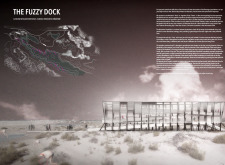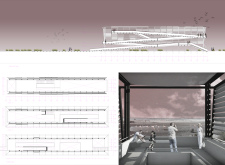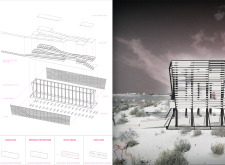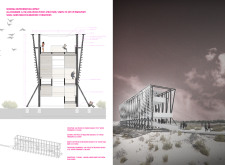5 key facts about this project
The Fuzzy Dock’s primary function is to serve as an observation platform, allowing visitors to engage with the unique ecosystem of the wetland without intruding upon it. The structure is designed to elevate visitors above the landscape, providing unobstructed views of flamingos and other wildlife while ensuring that the natural habitat remains intact. The architectural form encourages exploration and invites users to navigate the space leisurely.
Unique Design Approaches
One of the distinctive features of the Fuzzy Dock is its use of a modular design strategy. This allows for efficient assembly while minimizing environmental impact, ensuring that the construction process does not adversely affect the ecology of the wetlands. The structure includes a looping ramp for circulation instead of traditional staircases, promoting accessibility and enhancing user experience by facilitating a continuous flow throughout the observation areas.
The exterior of the Fuzzy Dock is characterized by a louvered skin composed of bleached sealed wood, which serves both functional and aesthetic purposes. The louvers provide shade while allowing for controlled views of the landscape, creating a dynamic interplay between the interior and exterior environments. The incorporation of organic forms into the design further blurs the lines between architecture and nature, encouraging visitors to immerse themselves in the surrounding ecosystem.
Design and Material Considerations
The Fuzzy Dock showcases a minimal yet effective material palette, utilizing stained and bleached sealed wood for structural and aesthetic elements. The use of these materials ensures both durability and visual compatibility with the local environment. The raised structure is supported by manually excavated pile foundations, which minimize soil disruption and maintain the integrity of the wetland ecosystem.
Key architectural details include various observational platforms that extend from the main structure, allowing for diverse vantage points across the wetlands. Flexible seating arrangements facilitate prolonged stays, encouraging visitors to spend time in the space and enhancing their engagement with the environment.
The Fuzzy Dock stands as an example of how architectural design can meet ecological considerations while fulfilling functional needs. It promotes interaction with nature through thoughtful design, providing an educational experience about the local ecosystem and the importance of conservation. For more insights into the architectural plans, sections, designs, and ideas behind this project, explore the detailed presentation available.


























